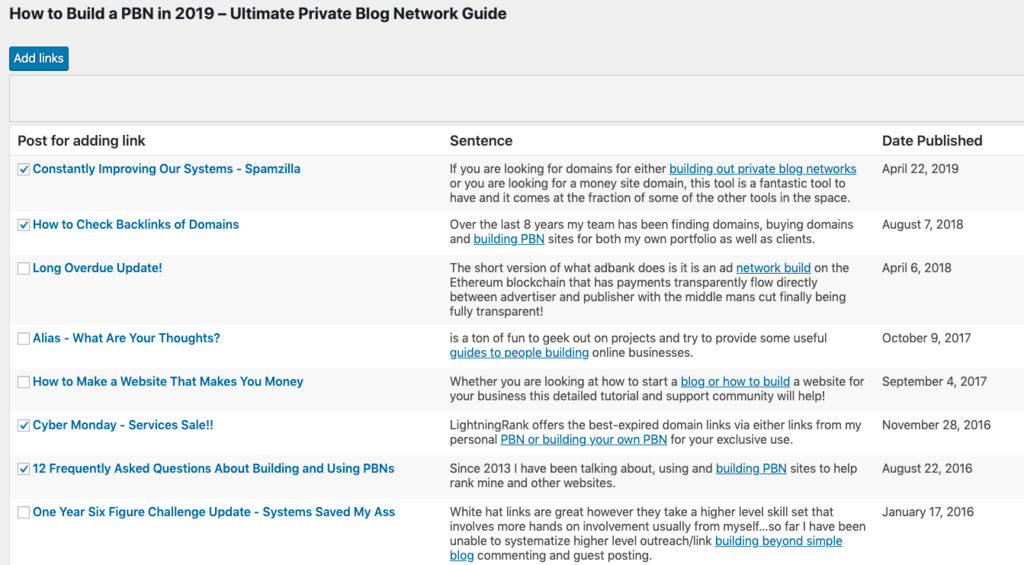Do Internal Links Matter for SEO and How To Build Them Systematically – LinkWhisper Review

There are some things in life you KNOW you should do, and they aren’t hard to do, but they just don’t seem to get done. Internal link building is one of these!
You finish your post, get everything ready to publish, publish and then think: ****, I should really should have built some internal links!
This post will show you how to do this in 5 minutes using this tool for your site so that you never have to worry about internal linking again.
I am going to cover…
● First: Sharing some data analysis that the guys at AuthorityHacker did which shows that YES, internal links really do matter for ranking in Google.
● Second: Showing how this can be done systematically through LinkWhisper (plus my review of this tool).
(‘Data’ and ‘systematically’… 2 of my favourite words. This will be fun…)
One of the most popular books of the year is James Clear’s Atomic Habits, which explains how small, repetitive tasks which become habits and have compounding effects to transform our lives. How does that relate to internal link building? This post covers one of those small simple tasks that will have ongoing compounding benefits to your site. By making the process of internal link building easier, faster, and automatic, you can systematize a good habit!
First: Do internal links matter for SEO?
Short answer is yes!
Internal linking matters for more than just SEO purposes, but for the purposes of this article we are focusing on the SEO benefit.
Don’t let internal link building for SEO purposes distract from the more important issue of user experience and driving traffic to your $ pages.
The guys at AuthorityHacker–specifically Michal Ugor–have created a fantastic article digging into the data of 1 million links.
See their full article here: Internal Links. Great article that goes into this topic in more detail!

The bottom line:
1. Pages that rank higher in Google averaged having more internal links pointing to that page than pages that didn’t rank as highly.
2. Anchor text matters for internal links and you can be more aggressive with exact match than typically you would be for off page links.
3. A decent rule of thumb is to have 5 internal links linking out for every post and, for the pages you want to rank, up to 100 internal links pointing to them. As with most rules of thumb this will have limited application.
a. NOTE: I was shocked when I saw my average was under 1 for outbound internal links on my posts!
Second: How to Systematically Structure & Sculpt Them? LinkWhisper Review
So we know links matter and would all love to spend the time analyzing and optimizing them for every post. The reality is most of us don’t have that time.
So what is the solution? How do we get the majority of the benefit as efficiently as possible?
That is where LinkWhisper comes in, a great new tool from Spencer Hawes of NichePursuits.
Here are the steps I use, leveraging SEMRush to identify the opportunities and LinkWhisper to systematically build internal links.
Note: Any time you systematically do something it is not as ideal as fully sculpting the page rank flow with a site architecture plan. But, for the busy online entrepreneur looking for a systematic solution, I hope this helps.
Procedure for Automatically Internal Link Building
1. Identify Opportunities using SEMRush (this is optional and can all be done with LinkWhisper)
a. Note this is similar to the significant success we have had identifying the content that needs a refresh and upgrade. We are excited to combine both upgrades and internal link structure improvements to the key pages we care about and see the results!
b. Go to SEMRush and sign in
c. Enter the Domain in question

d. Go to Organic Research
e. Keyword Identification – Select metrics of ‘Position 4-20’ and ‘traffic 100+’
- The key here is to identify low hanging fruit on keywords where a small impact in link juice being passed to them will improve their ranking.


f. Export to tracking sheet–see free copy of sheet you can copy
g. Page Identification–What are the top 10-20 pages you care about? You can use Google Analytics for this or SEMRush

h. Create final plan using judgement around what pages are low hanging fruit for boosting traffic and what pages you most care about

2. Install LinkWhisper and use the sheet you made in step 1 to set it up
a. Purchase LinkWhisper here
b. Install LinkWhisper

c. Activate LinkWhisper
d. Wait for InternalLinksReport (2-5 minutes)

e. Refer to the plan you made in step 1 and systematically go through each page adding internal links for the ones you care about

3. If LinkWhisper doesn’t have any recommended internal links
a. Search Google to identify top pages for the keyword you are wanting to rank for sitel:yourdomain.com “keyword” the results should show #1 as the page you are wanting to rank for the keyword and then the next 5 pages are likely great places to put an internal link back to your target page.

b. Edit page(s) and add link back to the main page you are wanting to rank for that keyword

Conclusion
Internal link building matters and is often neglected.
LinkWisper and some manual work is a great way to efficiently get your internal link building game back in order!
Hope this actionable article was helpful!




